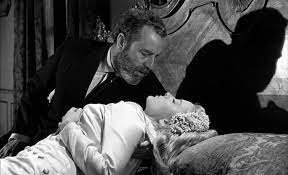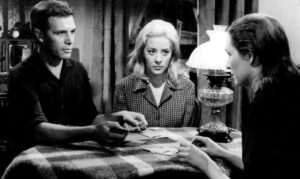“Viridiana” – Buñuel’s Blasphemous Movie

Title: “Viridiana”
Release Date: 1961
Director: Luis Buñuel
Cast: Silvia Pinal, Francisco Rabal, Fernando Rey, Margarita Lazano, Victoria Zinny
Buñuel made “Viridiana” an interpretation of his rebellious views. As a result, the Cannes-winning film was banned in Spain for many years, and the director himself was forced to leave the country.
“Viridiana” was made in 1962 as a Spanish-Mexican co-production. Interestingly, it was the first film Buñuel made in his native country after returning from a long exile. The iconoclastic filmmaker known in Europe for his scandalous “The Golden Age” (1930) was to regain his rightful place in Spanish cinema and show the world his talent. Therefore, he received all the necessary resources and with the full blessing of the state realized his picture. He even received the Palme d’Or at Cannes for “Viridiana” – the first such award in the history of Spanish cinema, winning with Poland’s “Mother Joan of The Angels”.
However, immediately after the festival a storm broke out. Due to the intervention of the Vatican, Buñuel’s film was accused of blasphemy, which resulted in a number of unpleasant consequences. The work was censored, and the director himself once again left Spain. “Viridiana” had its Spanish premiere only in 1977. What so upset the Catholic hierarchy?

“Viridiana” – a parable about the failure of the Christian vision of the world
The titular “Viridiana”, played by Sylvia Pinal, is a young girl who wants to become a nun and is about to take her perpetual vows in a convent. Nonetheless, just before this event, she receives a letter from her wealthy uncle (played by Fernando Rey), who asks her to pay him one last visit. Reluctant to the idea, Viridiana, at the express request of her mother superior, goes to the relative’s house. On the spot, it turns out that the uncle has deeper feelings for the girl and wants her to become his wife. He convinces Viridiana to wear his dead wife’s wedding dress, then drugs her with sleeping pills and intends to rape her. In the morning, he tells her that she has lost her chastity and cannot return to the monastery.
“Viridiana” decides to become a nun against all odds, but on her way back to the convent she receives news of her uncle’s suicide and returns to his house to set up a poorhouse. At the same time, his illegitimate son Jorge (Francisco Rabal) appears at his uncle’s estate. It soon turns out that Viridiana’s charity work is counterproductive.
While she is away, beggars are having an orgy in her house, and when the owner and Jorge unexpectedly return, two men throw themselves at her to try and rape her. The situation is saved at the last minute by Jorge, who in exchange for a large sum convinces one of the beggars to kill his companion. In the final scenes, a shaken Viridiana burns a cross and other objects of worship and then goes to Jorge’s room to join in a card game with his lover.

“Viridiana” – Spain’s mystical spirit and painterly inspirations
“Viridiana” is a film that expresses opposition to the institutional form of religion that, according to Buñuel, kills the essence of Christian values. For it presents an idealized, and therefore untrue, image of the world. The bright monastery, which is a symbol of the institution of the church, is in stark contrast to the darkness of her uncle’s house, and the angelic figure of the main character stands out against the background of repulsive beggars. It is not about the dualism of good and evil, however, but about emphasizing the incompatibility of sublime images with reality.
The gallery of characters seems to be taken from biblical parables, for there is the Leper, the Blind Man, the Chromy and the Harlots. Nevertheless, instead of sympathy, they arouse disgust. Buñuel’s world of the poor resembles the grotesque “The Caprices” of Francisco de Goya. The director also uses painterly associations in the key scene of the beggars’ feast, stylized on Leonardo da Vinci’s “The Last Supper”. The poor line up for a “photograph” taken by one of the women, lewdly pulling up her skirt. It was this part of the film that the Catholic hierarchy found most blasphemous. Buñuel’s intentions, however, do not boil down to a travesty of the Bible, but rather expose what da Vinci signaled in his work – the Judas-like betrayal lurking in the very heart of Christianity.
“Viridiana” – the mystical spirit versus the ethics of the body
Trying to save the world without understanding and accepting the frailty of human nature is always doomed to failure, the Spanish director seems to be saying. For this reason, Viridiana’s project cannot succeed. She denies the truth not only about the reality that surrounds her, but also about herself. In a conversation with her mother superior, the girl proudly states that she will certainly not fall. Viridiana even feels superior to her charges and to Jorge, who is living in sin. In this way, she becomes the epitome of an institution that claims to be infallible and to have a monopoly on truth.
What’s more, the protagonist’s masochistic practices of mortification constitute a negation of human corporeality. These elements of Christianity are particularly strong in Spanish culture, rooted in the experiences of famous mystics. Nonetheless, Viridiana’s mistake lies in the fact that she does not allow for the idea that darkness is also inside her. The perverse ending of Buñuel’s painting can be interpreted ambiguously. On the one hand, it suggests that the protagonist does not pass the difficult test of confronting reality, which leads to the rejection of the Christian system of values. Viridiana thus falls from one extreme to the other – she joins an erotic triangle. However, one can see in the final behavior of the girl a full acceptance of life and its imperfections.
Literature:
E. Królikowska, “Śladami Buñuela. Kino hiszpańskie”, Warszawa 1988.
